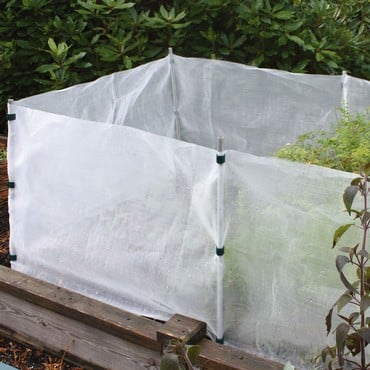With this Carrot Root Fly Trap system - containing 5 orange non-toxic sticky traps, a field pole, securing and fixing clips - you'll have everything you need to monitor the presence of Carrot Root Fly in carrot crops for up to two years.
Place the orange Carrot Root Fly Traps at the end of carrot rows in mid April to intercept the first generation of carrot fly and relocate the simple to move traps in late May before re-positioning in mid-July for the second generation of this persistent pest. The data is easy to analyse; if more than one carrot fly is caught per day then take remedial action with Carrot Root Fly Killer nematodes or our Anti Carrot Root Fly Screen. It's safe to finally remove the Carrot Root Fly Traps at the end of August. Replacement sticky traps for the Carrot Root Fly Trap are available separately.
- Carrot Root Fly trap helps monitor and catch carrot root fly adult
- Orange coloured sticky traps attract and catch the carrot root fly
- Warns of early attack and helps with timing of nematode treatments against carrot root fly larvae
- Trap can be re-used each year with new sticky boards
- Helps with chemical free control of carrot root fly
- Contains 5 orange non-toxic sticky traps, field pole and securing and fixing clips
- 5 trap refill packs of sticky traps available separately.
- Monitor crops for up to 2 years
- Intercepts the 1st and 2nd generation of Carrot Root Fly adults
Product Reviews

Using Your Carrot Root Fly Trap
The trap is made from orange plastic with the surface covered in sticky glue. The colour of the trap helps attract the carrot root fly adults onto its sticky surface where they are caught. The trap is also positioned at an angle shown to further enhance the catch rate of the trap. The trap is supplied with a field pole, fixing clip and 5 orange sticky boards. The traps should be placed around the edges of raised or open beds where carrots have been sowed and should in place by the time the first carrot seedlings emerge. Once the traps are full of insects or if they get covered in dirt or dust, replace the sticky traps with new boards. 5 are supplied with the product and refill packs are available.
Carrot Root Fly Appearance and Lifecycle
Carrot root fly (Psila rosae) is about 8mm long with a red to brown head. The body is black and similar to ant with wings. The female adult carrot root fly lays eggs in the soil beside the plants it attacks. The first eggs are laid in April-May from adults that have emerged from over-wintering pupae. There are normally 2-3 generations per year. The eggs hatch into larvae in about 7 days. The second generation appears through July and August.
Symptoms and Damage
The carrot root fly larvae feed on root hairs and then burrow into the stems and roots of plants. Seedlings and transplants are very vulnerable to attack. Carrot root fly attack carrots, parsnips, celery and parsley. First symptoms are a reddish tinge to carrot leaves appearing and plants wilting. The creamy coloured larvae of the carrot root fly burrow into roots and allow secondary rots to get into the carrots.
Natural Choice Treatments
There are now a number of products that can help protect carrots from carrot root fly. Invest in an essential early warning system in the form of carrot root fly traps to warn of carrot fly presence in crops and for more comprehensive control, we have nematode treatments for killing the carrot root fly larvae. There are also barriers and fleeces that can be used to protect carrots from attack.




























